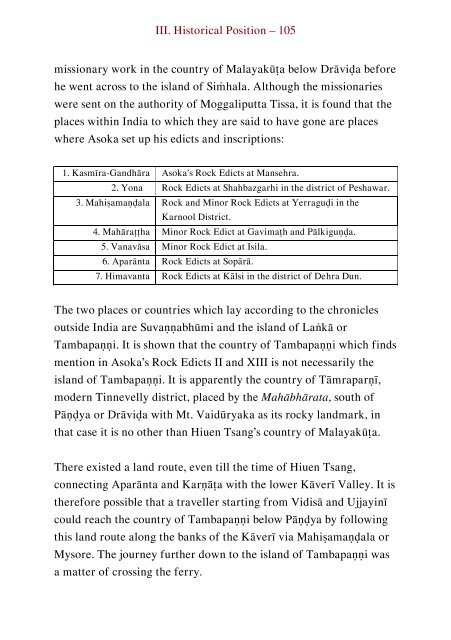On the Chronicles of Ceylon
A judicious appraisal of the various Chronicles that were written in Sri Lanka, assessing their chronology, literary and historical character.
A judicious appraisal of the various Chronicles that were written in Sri Lanka, assessing their chronology, literary and historical character.
- No tags were found...
Create successful ePaper yourself
Turn your PDF publications into a flip-book with our unique Google optimized e-Paper software.
III. Historical Position – 105<br />
missionary work in <strong>the</strong> country <strong>of</strong> Malayakūṭa below Drāviḍa before<br />
he went across to <strong>the</strong> island <strong>of</strong> Siṁhala. Although <strong>the</strong> missionaries<br />
were sent on <strong>the</strong> authority <strong>of</strong> Moggaliputta Tissa, it is found that <strong>the</strong><br />
places within India to which <strong>the</strong>y are said to have gone are places<br />
where Asoka set up his edicts and inscriptions:<br />
1. Kasmīra-Gandhāra Asoka’s Rock Edicts at Mansehra.<br />
2. Yona Rock Edicts at Shahbazgarhi in <strong>the</strong> district <strong>of</strong> Peshawar.<br />
3. Mahiṣamaṇḍala Rock and Minor Rock Edicts at Yerraguḍi in <strong>the</strong><br />
Karnool District.<br />
4. Mahāraṭṭha Minor Rock Edict at Gavimaṭh and Pālkiguṇḍa.<br />
5. Vanavāsa Minor Rock Edict at Isila.<br />
6. Aparānta Rock Edicts at Sopārā.<br />
7. Himavanta Rock Edicts at Kālsi in <strong>the</strong> district <strong>of</strong> Dehra Dun.<br />
The two places or countries which lay according to <strong>the</strong> chronicles<br />
outside India are Suvaṇṇabhūmi and <strong>the</strong> island <strong>of</strong> Laṅkā or<br />
Tambapaṇṇi. It is shown that <strong>the</strong> country <strong>of</strong> Tambapaṇṇi which finds<br />
mention in Asoka’s Rock Edicts II and XIII is not necessarily <strong>the</strong><br />
island <strong>of</strong> Tambapaṇṇi. It is apparently <strong>the</strong> country <strong>of</strong> Tāmraparṇī,<br />
modern Tinnevelly district, placed by <strong>the</strong> Mahābhārata, south <strong>of</strong><br />
Pāṇḍya or Drāviḍa with Mt. Vaidūryaka as its rocky landmark, in<br />
that case it is no o<strong>the</strong>r than Hiuen Tsang’s country <strong>of</strong> Malayakūṭa.<br />
There existed a land route, even till <strong>the</strong> time <strong>of</strong> Hiuen Tsang,<br />
connecting Aparānta and Karṇāṭa with <strong>the</strong> lower Kāverī Valley. It is<br />
<strong>the</strong>refore possible that a traveller starting from Vidisā and Ujjayinī<br />
could reach <strong>the</strong> country <strong>of</strong> Tambapaṇṇi below Pāṇḍya by following<br />
this land route along <strong>the</strong> banks <strong>of</strong> <strong>the</strong> Kāverī via Mahiṣamaṇḍala or<br />
Mysore. The journey fur<strong>the</strong>r down to <strong>the</strong> island <strong>of</strong> Tambapaṇṇi was<br />
a matter <strong>of</strong> crossing <strong>the</strong> ferry.


















